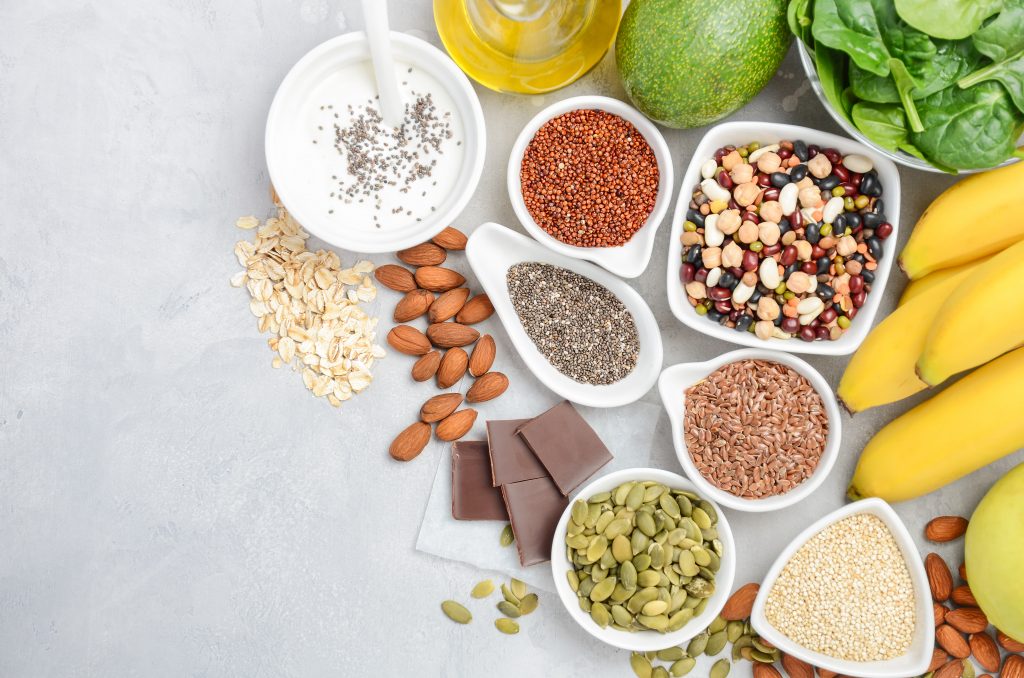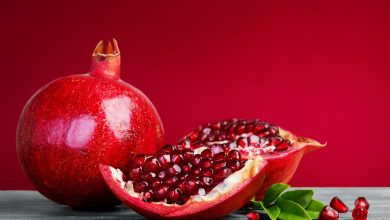Nutrients Missing From the American Diet

The national survey to investigate dietary deficiencies in the US showed that there are several nutrients missing from the American diet. The highest vitamin deficiencies were seen in vitamin A, C, D, E and K. Americans were also found to have a low intake of calcium, magnesium, iron and potassium. (1) (2)
Here are some of the key nutrients that Americans are not getting in their diets.
1. Calcium

It appears incredible that Calcium is one of the nutrients missing from the American diet despite the attention that it has received. You may have learned about the importance of calcium for bone health in elementary school. However, calcium is necessary for several other reasons like maintaining fluid balance in cells, regulating heart beat, nerve impulse transmission, blood clotting and muscle contraction. (3)
Unfortunately, over 40 percent of US population does not get the recommended daily intake of calcium. (4)
The recommended calcium intake is 1,000 mg for adults between the ages of 19 and 50 years. Growing children also have similar requirements as adults for calcium due to their growing bones. (5)
One of the best ways of getting enough of this key mineral is to consume dairy products on a daily basis. A low fat, 8 ounce serving of yogurt can provide around 400 mg of calcium. Yogurt is easier to digest than other dairy foods and is also beneficial for gut health due to its high probiotic content.
2. Iron

Iron deficiency is a global problem. Over 25 percent of the world’s population is low in this vital mineral. (6)
In the US, 9% of children aged 1 to 2 years are deficient in iron as are 9 to 11 percent of adolescent and adult females. (7)
Iron is a major component of red blood cells and is necessary for enabling these cells to deliver oxygen throughout the body. An iron deficiency can disrupt the adequate supply of oxygen for the whole body. It is not surprising that a lack of iron can lead to mental exhaustion and fatigue. Iron deficiency can affect your mental performance and immunity. Pregnant women risk low weight or premature babies if they have an iron deficiency. Iron is necessary for maintaining healthy cells, nails, hair and skin. (8)
Some of the best sources of iron include spinach, shellfish, liver, organ meats, legumes, red meat, pumpkin seeds, quinoa, turkey, tofu, dark chocolate, broccoli and fish.
One 100 gram serving of beef liver provides 6.5 milligrams of iron which is around a third of your daily requirement. (9)
3. Vitamin D

Popularly known as the sunshine vitamin, Vitamin D is essential for preventing rickets and osteoporosis. Vitamin D enables your body to absorb phosphorus and calcium. The vitamin can help to maintain normal levels of calcium in the blood and hence finds use in the treatment of kidney diseases and bone loss. (10)
According to a study published in the Journal of the American Medical Association, around three quarters of teens and adults are deficient in this vitamin. These numbers reflect that the percentage of the US population with this nutritional deficiency is increasing. Unfortunately, the deficiency was the worst in African Americans. Only 3% of this group were found to have adequate vitamin D levels. (11)
There appears to be a lack of consensus about vitamin D requirements. The US Institute of Medicine recommends a daily vitamin D intake of 400 to 800 IU for a blood level of 20 ng/ml. (12)
However, the Endocrine Society considers vitamin D blood levels of 30ng/ml to be adequate. (13)
There is scientific evidence that certain individuals may have higher vitamin D needs. According to the results of one study, a daily intake of 1680 IU or twice the amount recommended by the US Institute of Medicine was necessary to maintain adequate vitamin D levels in the blood. Certain individuals in this needed as much as 5000 IU to reach the normal blood level. (14)
Research on the vitamin D requirements of post menopausal women suggests that 800 to 2000 IU of vitamin D is necessary for maintaining the minimal required blood level of 20 ng/ml. higher doses were necessary for vitamin D blood levels to touch 30 ng/ml. (15)
Obese and overweight individuals need higher intakes of vitamin D for normal blood levels. (16)
The best way of getting vitamin D is through sun exposure. Light skinned people need less sun exposure than dark skinned people to meet their vitamin D intake. 5 to 30 minutes exposure of the arms and legs in strong sunlight can produce adequate vitamin D in light skinned people. (17)
If you live far away from the equator, then you may not get enough sunlight for adequate vitamin D during certain months of the year particularly winter.
Some of the best food sources of vitamin D include fatty fish (salmon, mackerel, tuna, etc.), egg yolks, cheese, beef liver and vitamin D fortified foods.
4. Vitamin B12

Around 40 percent of the US population may be deficient in vitamin B12 or close. The Framingham Offspring Study found that 39% of participants numbering around 3,000 were deficient. (19)
Vitamin B12 is an essential nutrient that is necessary for making the DNA, keeping the blood and nerve cells healthy and preventing megaloblastic anemia. Adults need around 2.4 micrograms of vitamin B12 each day. (20)
Some of the best sources of the vitamin are clams, beef liver, dairy products, eggs, poultry, meat and fish.
5. Magnesium

Magnesium has many vital uses in the human body such as keeping bones strong, regulating heart rate, supporting immune function, and maintaining normal muscle and nerve function. (21)
According to one study, over 70% of the US population may be deficient in this key mineral.
Magnesium rich foods include legumes, peanut butter, tuna, dark chocolate, tofu, spinach, banana, almonds and avocados.
6. Sulfur

According to one study, a significant proportion of the population may be deficient in sulfur. This is one of the nutrients missing from the American diet due to many minerals being stripped from American soil where produce is grown through chemical fertilization.
Sulfur has many uses in the human body. Sulfur is necessary for the production of insulin, keratin (an important substance for healthy skin and hair), collagen (which gives skin its elasticity), amino acids and antioxidants (which includes the most important antioxidant glutathione). (23) (24)
The best sources of sulfur include poultry, beef, eggs, dairy, seafood, broccoli, kale, turnips, garlic and onions.
7. Selenium

According to the results of one review study, around one billion people worldwide are deficient in the key mineral selenium making it one of the key nutrients missing from the American diet.
Selenium has several uses in the human body like protection against free radical damage, DNA production, thyroid gland function and reproduction. (26) Selenium-rich foods include Brazil nuts, eggs, sunflower seeds, brown rice, shrimps, prawns, mushrooms, beef, and cottage cheese.
North American Nutra’s Selenex GSH floods your cells with superfoods that are missing in the American diet! This all-natural formula restores the important minerals that modern chemical fertilizers have removed from our diets. Click to learn more about Selenex GSH.
References
(1) https://lpi.oregonstate.edu/mic/micronutrient-inadequacies/overview
(2) https://www.cdc.gov/nutritionreport/pdf/4page_%202nd%20nutrition%20report_508_032912.pdf
(4) https://health.gov/our-work/food-nutrition/2015-2020-dietary-guidelines/advisory-report
(5) https://ods.od.nih.gov/factsheets/Calcium-HealthProfessional/
(6) https://www.who.int/nutrition/publications/micronutrients/anaemia_iron_deficiency/9789241596107/en/
(7) https://www.ncbi.nlm.nih.gov/pubmed/9091669
(8) https://www.webmd.com/vitamins-and-supplements/features/iron-supplements#1
(9) https://fdc.nal.usda.gov/fdc-app.html#/food-details/168626/nutrients
(10) https://www.webmd.com/drugs/2/drug-10175/vitamin-d3-oral/details
(11) http://archinte.ama-assn.org/cgi/content/full/169/6/626
(12) https://www.ncbi.nlm.nih.gov/pubmed/21118827
(13) https://www.ncbi.nlm.nih.gov/pubmed/18400738
(14) https://www.ncbi.nlm.nih.gov/pubmed/18541590
(15) https://www.ncbi.nlm.nih.gov/pubmed/22431675
(16) https://www.ncbi.nlm.nih.gov/pubmed/22431675
(17) https://www.ncbi.nlm.nih.gov/pubmed/12499343
(18) https://ods.od.nih.gov/factsheets/VitaminD-HealthProfessional/
(20) https://ods.od.nih.gov/factsheets/VitaminB12-Consumer/
(21) https://medlineplus.gov/ency/article/002423.htm
(22) https://www.ncbi.nlm.nih.gov/pmc/articles/PMC2198910/
(23) https://www.sciencedirect.com/topics/nursing-and-health-professions/sulfur
(24) https://www.sulphurinstitute.org/pub/?id=8c64bf34-bc30-5bd9-0719-f6de83f7e841




